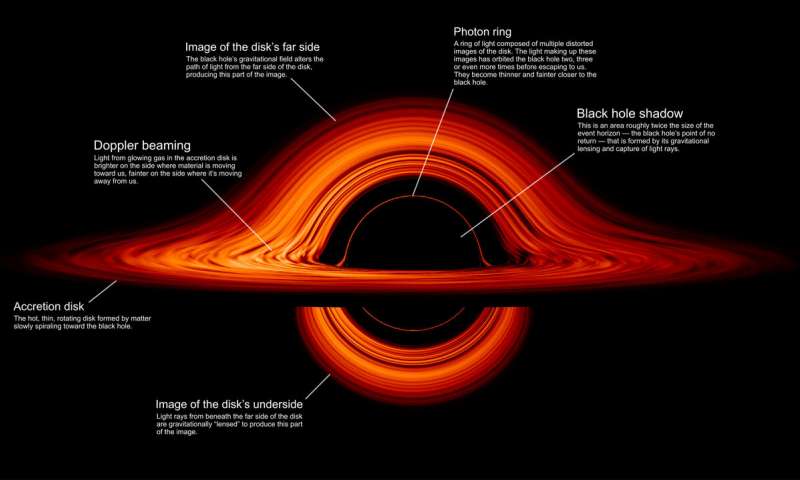At https://phys.org/news/2019-09-nasa-visualization-black-hole-warped.html … in the image below, a turbulent disc of gas is churning around a black hole which appears to have a double hump. The black hole's gravity alters the paths of light coming from different parts of the disc – but what we see depends on our vision angle. The visualisation simulates the appearance of a black hole where infalling matter has collated into a thin hot structure dubbed an accretion disc. The black hole is surrounded by the disc – a place of extreme gravity shining light and providing the misshapen appearance …
 … the image of course is a computer simulation rather than a true representation of an accretion disc surrounding a black hole. It is an elaborate construct and will please all the black hole buffs out there.
… the image of course is a computer simulation rather than a true representation of an accretion disc surrounding a black hole. It is an elaborate construct and will please all the black hole buffs out there.
At https://phys.org/news/2019-09-lucky-scientists-black-hole-shredding.html … a NASA satellite gave an unexpected glympse of a black hole ripping a star to shreds, we are told. It is known as a Tidal Disruption Event – which is mostly a flash of bright light. It ends by telling us scientists do not yet understand why tidal disruption events produce so much UV emissions and so few X-rays.
At https://phys.org/news/2019-09-black-hole-seeds-cosmic-garden.html … in the vast garden of the universe the heaviest black holes grow from small seeds. Nourished by the gas and dust they consume they grow in size to form the centres of galaxies. Presumably the seeds themselves must have been black holes of a sort but nobody has yet spotted any of them. Intermediate black holes are also absent and all we have are super massive black holes (as nourished by cosmologists from what had originally been black holes, period).
At https://phys.org/news/2019-09-black-holes-collision.html … three black holes are on a collision course we are told – as 3 galaxies approach each other.
At https://phys.org/news/2019-09-eyeballing-a-black-holes-mass.html … astrophyscists from Moscow's 'Institute of Physics and Technology' have derived a way to indirectly measure the mass of a black hole – and confim their existence. Active galaxy nuclei are among the brightest objects in space – a thin long beam of matter and energy directed outwards. The concensus is that the jets are produced by some kind of 'motor' in order to expel the burst of energy. A spinning black hole is assumed to power an entire galaxy. The jet is described as a flow of magnified fluid – an electrified gas (plasma).
